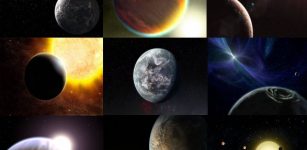Massive Exoplanet Nine Times Larger Than Our Jupiter – Discovered In Beta Pictoris System
Eddie Gonzales Jr. – MessageToEagle.com – Beta Pictoris b is a gas giant exoplanet that orbits an A-type star. Its mass is 11 Jupiters, it takes 21 years to complete one orbit of its star, and is 9.1 AU from its star. Its discovery was announced in 2008.
Now, astronomers have discovered a second giant planet in orbit around b Pictoris, a star that is relatively young (23 million years old) and close (63.4 light-years), and surrounded by a disk of dust.
 This artist’s impression shows how the planet inside the disc of Beta Pictoris may look. Only 12 million years old, or less than three-thousandths of the age of the Sun, Beta Pictoris is 75% more massive than our parent star. It is located about 60 light-years away towards the constellation of Pictor (the Painter) and is one of the best-known examples of a star surrounded by a dusty debris disc. ESO/L. Calçada
This artist’s impression shows how the planet inside the disc of Beta Pictoris may look. Only 12 million years old, or less than three-thousandths of the age of the Sun, Beta Pictoris is 75% more massive than our parent star. It is located about 60 light-years away towards the constellation of Pictor (the Painter) and is one of the best-known examples of a star surrounded by a dusty debris disc. ESO/L. Calçada
The β Pictoris system has fascinated astronomers for the last thirty years since it enables them to observe a planetary system in the process of forming around its star. Comets have been discovered in the system, as well as a gas giant, β Pictoris b, detected by direct imaging and described in 2009 by Lagrange’s team.
The team led by Anne-Marie Lagrange, a CNRS researcher at the Institut de Planétologie et d’Astrophysique de Grenoble (CNRS/Université Grenoble Alpes) analyzed more than 10 years of high-resolution data, obtained with the HARPS instrument at ESO’s La Silla Observatory in Chile, in order to indirectly detect the presence of β Pictoris c.
 Artist’s impression of the β Pictoris system. At least two giant planets, aged 20 million years at most, orbit around the star (which is hidden): β Pictoris c, the nearest one, which has just been discovered, and β Pictoris b, which is more distant. The disk of dust and gas can be seen in the background. © P Rubini / AM Lagrange
Artist’s impression of the β Pictoris system. At least two giant planets, aged 20 million years at most, orbit around the star (which is hidden): β Pictoris c, the nearest one, which has just been discovered, and β Pictoris b, which is more distant. The disk of dust and gas can be seen in the background. © P Rubini / AM Lagrange
This second giant planet, which has a mass nine times that of Jupiter, completes its orbit in roughly 1,200 days and is relatively close to its star (approximately the distance between the Sun and the asteroid belt, whereas β Pictoris b is 3.3 times more distant).
The researchers hope to find out more about the planet from the GAIA spacecraft data and from the future Extremely Large Telescope now under construction in Chile.
Written by Eddie Gonzales Jr. – MessageToEagle.com Staff










